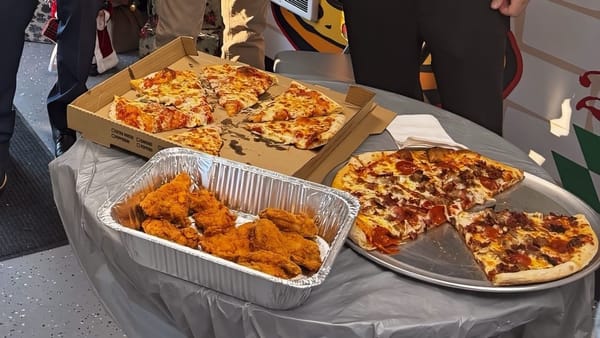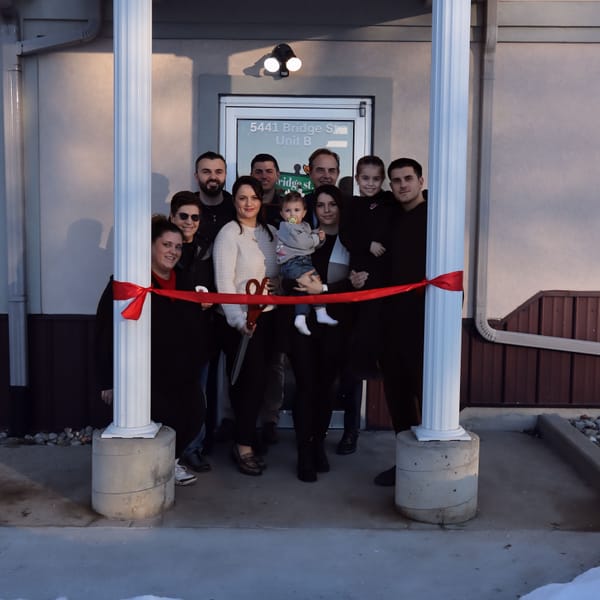"How do I know?" Experts explain how to recognize and prevent drug abuse in your home
Det. Richard Wistocki and Nick Gore spoke to parents and kids at Hononegah.

The second part in a drug education series called "Get Real About Drugs," Tuesday night's presentation was billed as a cooperative effort between Roscoe's Live REAL Foundation, Kinnikinnick School District, and Hononegah Community High School.
They weren't kidding. Hononegah Principal Chad Dougherty distributed handouts and Kinnikinnick Superintendent Keli Freedlund served as an usher. Bev Pomering of the Live REAL Foundation had an information table and gave out Deterra drug deactivation pouches.
The speakers at the meeting were recovering addict Nick Gore & Detective Richard Wistocki (Ret.) who gave an inside look at the signs and effects of drug abuse today.
While the audience was coming in, a TED talk by Wistocki was playing on the screen. An expert in cyber crimes and high tech crimes, he has also been active in stopping child predators, who resort to extortion and blackmail. His TED talk showed how a young person sending a compromising image to one "friend" could result in a predator threatening to send the picture to everyone she knows.
Gore and Wistocki spoke about legal drugs almost as much as illegal drugs. Wistocki pointed out that vaping can deliver a dose of nicotine, which is addictive in itself, but it can also deliver a dose of THC, the main compound in cannabis that produces a high, and in concentrated doses, a psychotic reaction that can require hospitalization. They warned parents that cannabis has become much stronger since they were in school. The average THC level in cannabis has increased from 4% in 1995 to 13% in 2016. Today, boutique growers are producing strains that top 30%.
Though cannabis is legal in Illinois for adults, parents should be aware that higher-dose effects of THC include difficulty thinking, making decisions, solving problems, distorted perceptions impaired balance and coordination, paranoia, problems with learning/memory, up to acute psychosis, delusions, and panic. Teen marijuana use has caused an increase in school dropout rates, higher unemployment rates, lower satisfaction with life, higher rates of welfare enrollment, and poor academic performance.
According to the CDC, nearly 841,000 people have died since 1999 from a drug overdose. Over 70% of drug overdose deaths in 2019 involved an opioid, and more than 70% of those were synthetic opioids, expecially fentanyl.
Wistocki has a dim view of vaping. Besides flavoring and nicotine or THC or both, a vape usually contains glycerin and glycol (antifreeze), but testing has also found acetaldehyde (paint stripper), acetone, acroline, benzene, cadmium, chromium, diacetyl, diethylene glycol (also antifreeze), formaldehyde (preserves specimens), isoprene, lead, nickel, propanol, propylene glycol, tin, and toluene.
Gore said that not all cannabis users move on to heroin, but almost all heroin users started with cannabis. He himself started drinking and smoking weed at 15 years old. A hockey player, "I was invincible." At 19 years old he developed kidney stones, was prescribed painkillers and became addicted. "I would steal pills from friends and family to feed my addiction from 21 to 26 years old."
After treatment, Gore is proof that recovery is possible. "I'm a husband, I'm a dad, I'm a true believer in God, I'm blessed because of presentations like these." He said the purpose of his presentations is "to warn, inspire, guide, and direct parents who are wondering, 'Is my kid doing drugs? How do I know?'"
Gore explained how addicts often "doctor-shop" to get drug prescriptions from multiple clinics, though 17.3% were prescribed by one doctor. But when asked, 55% of drug users obtained prescription drugs for free from friends or relatives. That's why the DEA sponsors a Drug Take Back Day several times a year, to keep unused prescriptions from being misused. The next one is Saturday, October 23, 2021, in Loves Park and Beloit.
Gore said that when he was an addict, he didn't need to go to seedy neighborhoods in Chicago to find drugs. Since cannabis is legal now, 'they get it from their parents." But most significantly, kids today use social media to order illegal drugs.
For free updates, subscribe to our free newsletter!
"So what does doing drugs have to do with social media?" asked Wistocki. "Everything!"
Many parents don't know, Wistocki said, that children under 13 are not legally allowed to have social media accounts. But most 4th and 5th graders say they sign up for Snapchat using the year 2000 as their birthdate. Not surprisingly, when adults encounter these children online, they assume they are 21-year-old adults.
Wistocki reminded parents that smartphones are a center of a young person's life and parents have the responsibility of knowing what's going in their child's life. "If you can monitor their social networks," he said, "you will know who they hang out with, where they're going, who they are dating, what parties they are going to, and what alcohol/drugs/sexual conduct they are into, if any."
Wistocki firmly told parents that their children don't have an absolute right to privacy. He demonstrated how Snapchat has a Your Eyes Only mode, and if that feature asks for a PIN number, your child is already using it to hide photos and videos. Another common hiding place looks and works like a calculator app, but also has a PIN number. Wistocki gives a pro tip: "your kid doesn't need two calculators on their phone." To monitor a child's cell phone and social networks, Wistocki recommends the Bark app. Parents can contact their school's IT department to get information about what their child is doing on their school-issued Chromebook, which the school monitors using GoGuardian.
"But I follow my kid's Instagram," some parents tell Wistocki. He smiles and asks how often their child posts to that account. Many young people have a "finsta" - a fake Instagram account - just for their parents to see. Their real online activity takes place on another account.
Gore and Wistocki showed pictures of what drugs look like. "What are some of the things you may find in their room?" Signs of heroin may include a white powdery substance, missing spoons, rolled-up dollar bills or plastic cards, cut up straws, foil balls, syringes, and Xanax bars. Marijuana users may have vapes, brownies, or pipes, not to mention cigarette rolling papers, roach clips, small glass vials, and small plastic baggies. If parents find a pill in the laundry, how do they recognize what it is? "There's an app for that," they say - several of them in your app store.
But the most obvious signs of teen drug abuse may not be physical. Wistocki advises parents to look for:
- Loss of interest in family activities
- Disrespect for family values
- Withdrawal from responsibilities
- Verbally or physically abusive
- Sudden increase or decrease in appetite
- Disappearance of valuable items or money - if they sell their game system, you know there must be a serious issue.
- Not coming home on time
- Not telling you where they are going to
- Constant excuses for behavior
- Spending a lot of time in their rooms
Detective Wistocki offers an effective if startling answer to the question "What is the answer to this problem?" He tells parents to give drug tests to their children. At-home tests are available at local drug stores.
"How do I ask my teen to take a drug test?" parents may wonder.
- Let your teens know that you love them too much to let them be involved with drugs.
- Assure them you will use any tool available to keep them away from drugs/
- This is a very effective means of helping to prevent teen drug use, especially by giving them a great excuse to say, "No thanks, my parents drug test me."
The Live REAL Foundation offers quick, free training in how to use naloxone hydrochloride, available as Narcan nasal spray, as first aid for an overdose of heroin, fentanyl, oxycontin, and other opioids. They even give out free naloxone kits to help save lives.
The speakers said that Fentanyl is so strong it may take several doses of naloxone to counteract its effects. Also, while naloxone saves lives, it immediately brings on withdrawal symptoms. The speakers advise friends and family to administer naloxone, call 911, and step back, because the patient won't be in a good mood.





